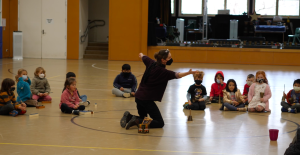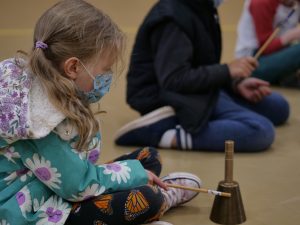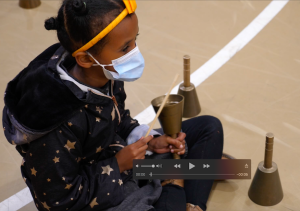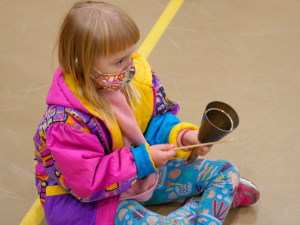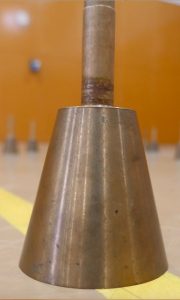Federation Bells Workshops and performance ‘Ringing in the Galaxy’ PHPS August – September 2022
‘The performance was SO amazing! What an experience for all the students. Not just in music and sound but science, the environment, the land they live in – this is exactly the way the bells work the best.’ Biddy Connor, curator for the Federation Handbells at Museums Victoria.
The Federation Hand Bells were commissioned in 2001 as part of a project to celebrate the centenary of Federation. Organised into sets of 24 bells from 2 chromatic octaves, the Bells are played with a mallet on the outside surface of the bell. Techniques for playing also include a bow drawn across the top, non-metallic objects rattled inside, and even fingers and fingernails on the bells’ surfaces.
Having personally gigged with the Federation Handbells and taken them them to Estonia for performances, Princes Hill Primary School music specialist Deb Kayser understood their capacity to inspire and uplift through sound and vibration; she recognised the magic of the bells. In 2022, she resolved to bring them to the children, parents and staff of Princes Hill Primary School.
Former head of Percussion at Melbourne University, Peter Neville along with Elissa Goodrich, a composer and musician who creates community events often using the bells, came on board with the project. Harpist Genevieve Fry joined in for the performance day.
‘Cosmology’, a song by Icelandic musician Björk provided the provocation for the soundscape the children of Princes Hill would create with the bells. This song of wonder tells the creation story/myth from different cultures across the world. Björk said that her choice of instrumentation for this song was intentionally for instruments created from metals pulled out of the earth.
So, with this as inspiration, lots of imagination and the silicon bronze Federation Handbells, the children set out to explore the Galaxy.
The Bells Workshop ran over 6 weeks and culminated with a whole school performance in the final week. Students reflected on the role of the bell in culture and society, and explored a variety of techniques for playing the bells. Each Learning Neighbourhood chose a part of the Galaxy to inspire their sound music. They researched their chosen area of the galaxy and worked with Deb, Peter and Elissa to find ways of illustrating their ideas through sound.
The Performance
The performance began by ‘ringing in the Galaxy’ with all the whole school participating in a bell run* set up around the perimeter of the performance area. The audience were invited to interact with the bells at the end of the show.
*‘Bell Run’ – children run past the bells striking them with a chopstick.
Neighbourhood Soundscapes
Preps: Stars
The Preps began their presentation by singing ‘Twinkle Twinkle Little Star’ accompanied by the harp. Then each homegroup presented a constellation.
The Bell Constellation: using the higher pitched Fed Bells
The Chime-bar Constellation: chime-barsThe Pudding bowl Constellation: Pyrex bowls sourced from op-shops
Year 1: Galaxy Parade
Some students paraded props to represent their particular ‘galactic thing ‘as other students performed the chosen sound.
Milky Way: a collection of brass objects played with a metal mallet, and brass tubes bell tree.
Mars: The largest and lowest pitched Fed Bells played simultaneously with hard mallets in a repeated tremolo roll.
Space Junk: Clanking random stainless-steel objects
Space Whales: Rio Drums and African Kpmanlogo Drums with super-ball mallets.
Space Dancing Chickens: Several big Fed Bells upsidedown on the gym floor. Students tapped repeatedly the bell stalk with the wooden thick end of the bell mallets.
Year 2 Indigenous Astrology: Star Maps and Tides
The children used bells and percussion to share Indigenous star maps and tidal knowledge. They illustrated Indigenous understanding of the impact of the moon’s gravitational pull on water by using a painted curtain spot lit from behind to show the phases of the moon. This was accompanied by sound to represent the corresponding tides.
Year 3/4 Neighbourhood 1: The Black Hole from the Perseus Galaxy Cluster
NASA released the sound of the Black Hole from the Perseus Galaxy Cluster, in August 2023 during our Bell workshops. The children declared: ‘We sound just like the NASA recording!’
The students used tam-tams to create a low rumble combined with drums for additional deep whale-like groans. They then added cymbals, agitated by marbles and chains, to represent the hot gas which surrounds the black hole. Other students slowed down beats on the bells to illustrate the slowing of time as objects approach a black hole. Aligned to the sequence of the soundscape, students moved through the gym modelling space objects being sucked into black holes before being released back into space as radiation.
Year 3/4 Neighbourhood 2: The Language of Aliens and Aliens’ movement.
3/4 A – Language
Many students thought that Alien language should be an ugly and unsettling sound, while others thought that Aliens may in fact be friendly and not hostile monsters. It was decided that the raw sound of Alien language as heard by human ears would be rasping but when this sound was processed through a translation machine, it would be heard as melodious, calming and resonant!
‘Waldteufels,’ instruments made from fishing line, a paper cup and a ‘dolly peg’ created an eerie creaking sound – the raw Alien language sound. For the translated sound, the students gently played steel tongue drums. By matching pitch and phrasing they captured the rhythm of the translation process.
3/4 D – Movement
The children determined that when Aliens were in their natural habitat and unobserved by other species, they moved around freely making a ‘glumping’ sound. All the students placed their bells upside down on the rubber gym floor. Letting them drop back to the floor resulted in subtle random ‘glumps and glomps’ of different pitches. However, when Aliens wanted their presence to be undetected, they could move around without contacting the ground. Each bell has a unique interior texture which sounds soft and mysterious when finger nails we pulled quickly over the surface. This became the sneaky way that Aliens could move around undetected. It was also decided that Aliens could communicate telepathically across the universe with Morse Code like signals. Bells were held by their stalk and long sounds were made by striking the bell and letting the sound ring on; a short sound was made by striking the bell while holding the rim against a leg.
Year 5/6: The Milky Way Black Hole. Sagittarius A
The Year 5/6 students knew that there is a huge black hole at the centre of the Milky Way Galaxy. They learned that it is called Sagittarius A. Closely orbiting near it is an open star cluster of about one hundred and twenty stars called the Butterfly Cluster, and a constellation of stars that form the tail of the Scorpius Constellation called Lambda Scorpi. Astronomers have detected strong radio waves emitting from the black hole resulting from huge amounts of mass being concentrated into a smaller area of the black hole in a catastrophic collapse. The 5/6s found that they had a narrative to convert into a sound scape. The sounds of steel instruments were a focus of the 5/6 performance – the pinging and flanging bright sound of the steel drum, contrasted with the softer rolling steel tongue drums the students played.
Learning Outcomes
We were curious, excited and motivated, and we were all learning together.
The students thinking went deeper as they aimed for an authentic sound representation of the Galaxy. How would they sound space dust, the brilliance of stars, the slowing and stretching of time? They had to consider tempo, volume and pitch, and assign someone to coordinate the sound events. What would the choreography of the soundscape look like? The students were researchers, composers, listeners, evaluators, decision makers, leaders, followers, collaborators and in time, would be performers. They needed persistence to push through tricky developmental phases, and the confidence that challenges could be solved. The students had to memorise the soundscape, know their role, and listen carefully to control their contribution. They were focused, because they were invested in making this a truly awesome listening experience.
We found that learning areas would not stay in traditional boxes, and that joy lay in the magic of fluid thinking. Indeed, the more we questioned the impossible with ‘how can we make it possible?’, the more we understood that everything is connected and not a case of ‘us here on earth’ and the Galaxy out there.
Ring the Bells below to follow Deb Kayser’s story of the Federation Bells at Princes Hill Primary School.







